- Michael Burry
- Jul 15, 2025
Dysautonomia is a medical condition that disorders the autonomic nervous system and affects heart rate, blood pressure, digestion, and temperature control. In the United States alone, it affects millions of people. As stated by Dysautonomia International, over 70 million people globally have some form of dysautonomia, with a considerable number living in the U.S.
You will learn if dysautonomia is considered a disability under the Social Security rules and what criteria must be satisfied in order to apply for benefits and what type of medical documentation is usually needed. We will also discuss the importance of collaborating with a lawyer specialized in disability claims and how they can enhance your claim.
Is dysautonomia a disability?
Yes, Dysautonomia can be considered a disability if it limits your capability to hold a job for at least 12 months or more. Depending on the severity of the condition and its impact on an individual’s ability to perform daily activities and work, dysautonomia may qualify as a disability. The SSA will assess whether your condition meets the criteria outlined in the “Blue Book“ (the SSA’s official listing of impairments) or is equivalent to a listed condition qualifying for disability benefits.
What Is Dysautonomia?
Dysautonomia is a medical condition affecting the autonomic nervous system (ANS), which controls and regulates involuntary bodily functions. Without conscious effort, The ANS manages essential bodily processes, such as heart rate, blood pressure, body temperature, digestion, and respiratory rate.

Can I Get Long-Term Disability Benefits for Dysautonomia?
It is possible to get long-term disability benefits for dysautonomia if the condition significantly impairs your ability to work. However, whether a disability applicant is eligible or not depends on the insurance policy terms and the severity of the symptoms. Disability insurance policies define disability differently. It is necessary to thoroughly review the disability insurance policy and understand the terms and conditions before making a claim.
Disabling Symptoms of Dysautonomia
Dysautonomia can manifest with a wide range of symptoms, and the severity and combination of symptoms can vary from person to person. Some common symptoms of dysautonomia include:
- Abnormal sweating patterns, including excessive or inability to sweat.
- Nausea, bloating, constipation, diarrhea, or difficulty swallowing.
- Chronic fatigue or feeling exhausted, even after minor activities.
- Recurrent headaches or migraines.
- Difficulty concentrating, memory problems, or brain fog.
- Insomnia disrupted sleep patterns or sleep apnea.
- Vision problems, such as blurred vision or difficulty focusing.
- Increased anxiety and panic disorder, especially during symptomatic episodes.
What Are The 15 Types Of Dysautonomia?
While there are more than 15 types of dysautonomia, some of the most common and well-known types include:
- Postural Orthostatic Tachycardia Syndrome (POTS)
- Neurocardiogenic Syncope (NCS)
- Vasovagal Syncope
- Autonomic Neuropathy
- Multiple System Atrophy (MSA)
- Pure Autonomic Failure (PAF)
- Autoimmune Autonomic Ganglionopathy (AAG)
- Familial Dysautonomia (FD)
- Horner’s Syndrome
- Chronic Intestinal Pseudo-obstruction (CIP)
- Orthostatic Intolerance Syndromes
- Baroreflex Failure
- Autoimmune Autonomic Neuropathy (AAN)
- Postganglionic Autonomic Failure
- Central Autonomic Disorders
What Evidence Can Prove Dysautonomia As a Disability?
When you are applying for long-term disability owing to your dysautonomia, you are required to provide some comprehensive evidence that will help to support your claim. Medical evidence will depend on an individual and the causes of their disorder. Some examples of medical and vocational evidence that may help to support your long-term disability claim are as follows:
- Tilt Table Test which is an autonomic function testing. It is used to diagnose conditions like postural orthostatic tachycardia syndrome (“POTS”)
- A Cardiopulmonary Exercise Test (“CPET”) which is a diagnostic evaluation test. It is used to measure respiratory responses that have been caused due to physical exertion causing functional limitations
- Quantitative Sudomotor Axon Reflex Test (“QSART”) is used to measure sweat gland activity. It will help to diagnose various conditions such as small fiber neuropathy
- Blood tests may help to understand the causes of dysautonomia such as tests done for vitamin deficiencies, thyroid functioning, and autoimmune markers.
- Heart Rate Variability (“HRV”) Analysis is used to assess overall changes that have occurred in the heartbeat of an individual during the time
Some other tests are electrocardiogram (ECG), Holter monitor, electromyography, and others that may help to diagnose dysautonomia in a better way.
Eligibility Criteria For Dysautonomia Disability
To be eligible for disability benefits based on dysautonomia, you must meet the Social Security Administration’s (SSA) criteria. The SSA evaluates dysautonomia under the listing for Dysautonomia, Section 4.06, in the “Blue Book“. It is a comprehensive guide to medical conditions that qualify for disability benefits.
To meet the eligibility criteria for dysautonomia disability, you must have objective medical evidence that demonstrates the following:
- Chronic Dysautonomia: Your dysautonomia must be chronic, meaning it has persisted or is expected to persist for at least 12 months.
- Inability to Stand Up from a Seated Position: You must have significant difficulty standing up from a seated position due to dizziness, lightheadedness, or a drop in blood pressure.
- Inability to Stand for Extended Periods: You must have significant difficulty standing for an extended period, leading to an inability to carry out daily activities.
- Low Blood Volume: Your medical records should show evidence of a persistently low blood volume (hypovolemia) verified by medical testing, such as a tilt table test.
- Tachycardia or Bradycardia: Your heart rate should show evidence of either tachycardia (a heart rate of more than 120 beats per minute) or bradycardia (a heart rate of less than 60 beats per minute).
What If I Meet The Eligibility Criteria For Dysautonomia Disability?
If you meet the eligibility criteria of SSA, you may be eligible to receive dysautonomia disability benefits, which can provide much-needed financial support and access to essential resources. Some potential outcomes if you meet the eligibility criteria:
-
Approval for Disability Benefits: If the Social Security Administration (SSA) determines that your dysautonomia meets the disability criteria outlined in the “Blue Book” or is equivalent to a listed impairment, you will be approved for disability benefits.
-
Continuing Disability Review (CDR): Sometimes, the SSA may approve your disability benefits for a specific period, subject to a Continuing Disability Review (CDR). During a CDR, the SSA will periodically review your medical condition to assess whether your dysautonomia meets the disability criteria.
-
Appeal Process: If your initial disability claim is denied, you can appeal the decision. An appeal involves requesting a reconsideration, attending a hearing before an Administrative Law Judge, and further levels of appeal if necessary.
-
Medical Improvement: If your condition improves to the point where you no longer meet the disability criteria, you may no longer be eligible for disability benefits. However, the SSA will consider your medical improvement and may provide a transition period or work incentives to gradually facilitate your return to work.
How Much Is a Disability Check For Dysautonomia?
The approximate monthly Social Security disability check for disorders such as dysautonomia in 2022 was $1,550.43. However, the maximum possible benefit amount for dysautonomia in 2024 is $3,822 per month for Social Security Disability Insurance (SSDI) and $914 per month for Supplemental Security Income (SSI).
The maximum amount may vary depending on various factors such as work history, assets, and others. If you are applying for SSDI, then your work and income history will be calculated, whereas in SSI, your sources of income will be taken into consideration.
What If I Do Not Meet The Eligibility Criteria For Dysautonomia Disability?
If you do not meet the eligibility criteria for dysautonomia disability, you may apply for disability benefits. This is because it takes time and is a complicated procedure. Therefore, you must apply as soon as possible. On average, less applicants get approved for the benefits in the initial phase. Working with a disability attorney will help you to be on the right track and file an appeal within 60 days of the date of rejection.


